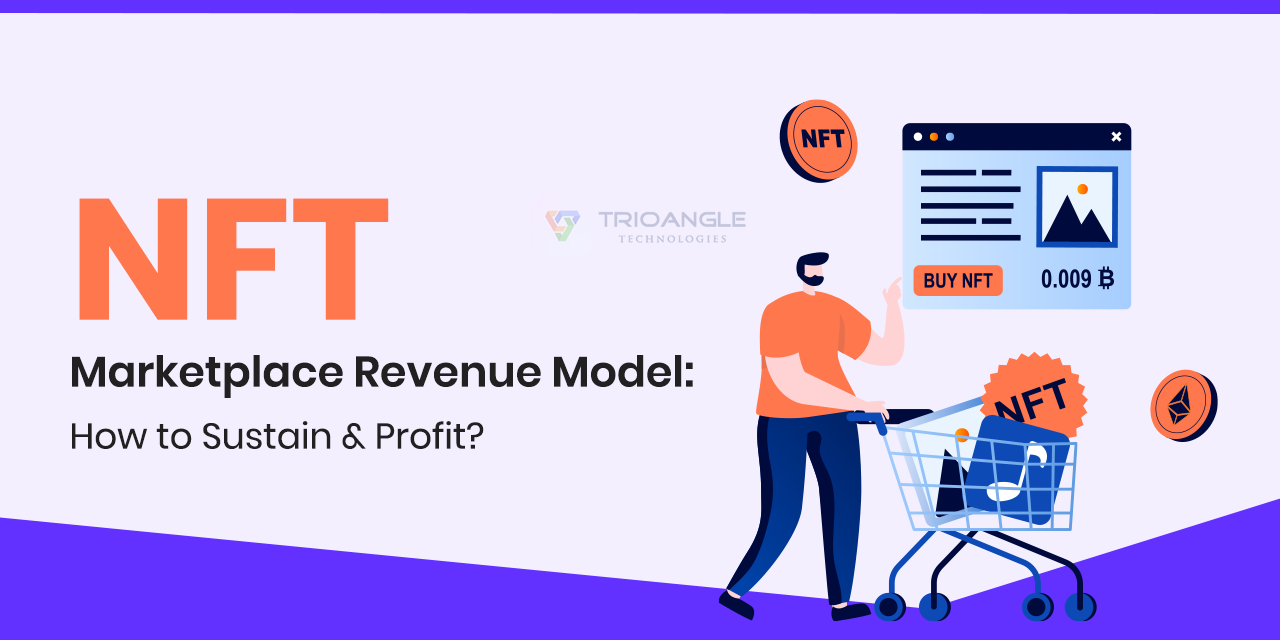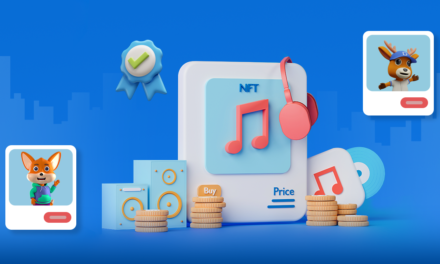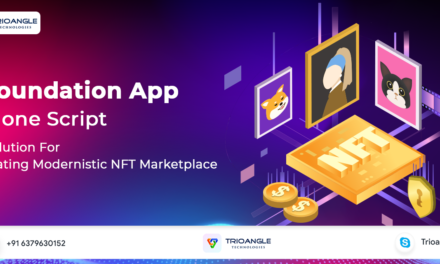Visualize walking into an amusement park… Filled with exciting rides, exciting crowds and many attractions. Now, think about how this park makes money.
Every ticket sold, every ride taken, every snack grabbed—it all adds up, right? An NFT marketplace functions in the same manner. Every sale, listing, and auction helps to drive revenue.
Like a well-managed amusement park… A successful NFT marketplace needs a clever revenue plan to maintain a steady income. Platforms such as OpenSea and Magic Eden didn’t emerge overnight with huge profits. They refined their NFT Marketplace revenue models to secure long-term success.
In our earlier blog, we covered various NFT Marketplace revenue models. Now, we will take it a step further… By examining how to optimize each stream for the greatest profitability. Whether you’re building from scratch or utilizing a clone script.
Choosing the right revenue model is crucial for your NFT marketplace development. It can be the key to transforming your platform into a successful business.
What is the NFT Marketplace Revenue Model?
The NFT marketplace represents a digital economy. Where each interaction can lead to financial gain. The NFT Marketplace Revenue Model is the backbone of this system. It outlines how the platform earns steady profits while enabling smooth NFT transactions.
In contrast to conventional e-commerce. Which relies on direct sales for profits. An NFT marketplace benefits from decentralized and diverse revenue streams. Instead of owning the NFTs…
The marketplace acts as a bridge—earning from the activity within its ecosystem.
Income streams come from
- Transaction fees on NFT sales.
- Listing fees for better visibility,
- Royalties that provide earnings for creators on resales.
- And subscription perks for exclusive access.
Advanced models may also include DeFi components like staking rewards and liquidity pools. Which enhances user interaction and increases revenue.
For NFT entrepreneurs, Succeeding with this NFT Marketplace revenue model goes beyond starting a platform.
NFT marketplace development can sustain itself and generate profits. At the same time, it can adapt to industry trends to stay competitive.
How an NFT Marketplace Development Can Be Your Key to Profitability
Getting into the NFT market is more than setting up a platform. It involves creating a profitable business. The success of platforms like OpenSea and Blur is not by chance. It results from NFT marketplace development with a well-planned NFT marketplace revenue model. It ensures profitability at all stages.
Here’s why an NFT marketplace is a strong business move:
#1 Ownership of a Digital Economy
Unlike standard businesses that depend on inventory. An NFT marketplace allows users to create, buy, and sell digital assets. It enables you to earn a part of each transaction.
#2 Revenue Without Direct Product Creation
While many online businesses focus on selling products or services. An NFT marketplace revenue model generates income from assets created by users. By utilizing a revenue model that includes fees, royalties, and memberships. Your NFT marketplace can earn money without the need for you to create NFTs.
#3 Low Operational Costs & High Automation
Smart contracts streamline the process of transferring ownership. It automates payments and manages royalties, which reduces operational costs. In contrast to traditional businesses. You don’t need warehouses, shipping, or extensive teams.
#4 Increasing Demand for Niche NFT Marketplaces
General NFT platforms are common. However, niche marketplaces focused on gaming, real estate, and music NFTs offer higher profits. and reduced competition. This gives you the chance to lead in specific fields. Instead of battling against large platforms like OpenSea.
#5 Future-Proof Business with Web3 Integration
NFT marketplace Development has expanded beyond digital art. They now connect with gaming, the metaverse, virtual real estate, and decentralized finance (DeFi). It promotes lasting business viability in the changing Web3 environment.
NFT Marketplace Revenue Models: Which Model Works Best?
A successful NFT Marketplace Development depends on a solid NFT Marketplace revenue model. It guarantees consistent profits and appeals to both buyers and sellers. Below are the main revenue models utilized by top NFT marketplaces:

#1 Commission-Based Model
In this model, the marketplace takes a set percentage from each NFT sale. Platforms such as OpenSea and Blur follow this approach. They usually charge between 1% and 5% for each transaction. It provides a steady revenue stream as the platform expands.
#2 Royalty-Based Model
This model enables NFT creators to receive a share of the profits from secondary sales. While the marketplace retains a part for processing these transactions. It supports creators and platforms that prioritize ongoing revenue, like Rarible and Foundation.
#3 Subscription-Based Model
Some platforms implement a subscription model. Charging users either monthly or yearly to gain access to premium features. Like lower transaction costs, special NFT launches, or advanced analytics. This approach guarantees consistent revenue and is beneficial for niche markets.
#4 Freemium Model
While marketplaces offer fundamental features for free. They charge for premium options like promoted listings, exclusive auctions, and unique trading tools. This approach helps them build a large user community. And earn money from advanced services.
#5 Ad-Based Model
Platforms generate revenue by enabling NFT projects to showcase their collections. Through paid listings, banners on the homepage, or highlighted drops. This approach is typical in busy NFT marketplaces.
#6 Hybrid Model
Many NFT marketplaces use a mix of strategies to increase their earnings. For instance, OpenSea charges commission fees and offers ad-based promotions. Whereas Rarible combines royalties, subscriptions, and premium features.
#7 NFT Launchpad Model
Marketplaces serve as platforms. It allows NFT projects to host and sell new collections to early investors. often charging fees for these services. This approach is frequently seen in GameFi and metaverse marketplaces.
Which Model Works Best?
The ideal revenue model varies based on the specific niche of your marketplace. Many successful platforms use a mix of models. Such as transaction fees for consistent income. Royalties for long-term viability, and advertisements or memberships for more earnings.
Entrepreneurs need to focus on both user experience and profitability to create a successful NFT marketplace.
Top Strategies to Diversify Your NFT Marketplace Revenue Model
To create a successful NFT marketplace, you should consider new revenue models. That goes beyond standard options like transaction fees and subscriptions.
Here are some creative strategies:
#1 NFT Fractionalization Services
Allow many investors to own a fraction of high-value NFTs, making them more accessible. Charge a service fee for overseeing these shared assets. This method makes costly NFTs available to more people. It boosts engagement on the platform.
#2 NFT Curation and Consultancy
Offer curation services to artists and brands venturing into the NFT market. Charge for professional advice on how to create, promote, and sell NFTs. It ensures high standards and is appealing to dedicated collectors.
#3 NFT Authentication and Verification
Establish strong verification services to confirm the authenticity of NFTs. It fosters trust with buyers. Collect a fee from creators for certifying their NFTs. Which will help minimize fraud and improve the credibility of the marketplace.
#4 NFT Collateralization and Lending
Provide users with the option to use their NFTs as loan collateral. Introduce interest rates or service fees for processing these lending deals. thereby adding a financial aspect to your marketplace.
#5 NFT-Based Events and Experiences
Organize virtual events or experiences that can be accessed via special NFTs. By selling these event NFTs, you can create unique ways for people to engage and generate extra income.
#6 NFT Insurance Services
Provide insurance coverage for valuable NFTs to protect against theft or loss. Collect premiums for these policies, ensuring collectors and investors feel secure.
#7 NFT Educational Workshops
Organize workshops and classes focused on creating, investing in, and understanding NFT technology. Set fees for participants, establishing your marketplace as a center for knowledge in the NFT space.
Adopting these new NFT marketplace revenue models can broaden your income sources. And it boosts user interaction. It sets your NFT marketplace up for long-term growth and success.
Bringing it all together…
NFT marketplace development isn’t about buying and selling digital assets. It’s about building an entire economy that generates revenue at every turn. With the right NFT Marketplace revenue model. Includes commission earnings and NFT-supported financial services. your platform can thrive, grow, and lead the market.
Choosing the right revenue streams is only part of the equation. You also need suitable technology, effective market positioning, and scalability to succeed. This is where Trioangle comes into play. As a leading NFT Marketplace Development company, We offer more than a Platform. We build NFT marketplaces that are developed for profitability, user engagement, and enduring success.
If you’re serious about launching a future-proof NFT marketplace. Don’t settle for the ordinary. Let’s build something extraordinary together.
With Trioangle, you don’t launch a platform… You create a digital economy that works for you!





